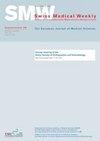National survey in Switzerland calls for improved diagnosis and treatment in children with scabies
IF 2.1
4区 医学
Q2 MEDICINE, GENERAL & INTERNAL
引用次数: 0
Abstract
AIM OF THE STUDY: The global prevalence of scabies is estimated to be up to 200 million cases annually, with young children particularly affected. In Europe, most cases are thought to originate in migrant populations. Scabies management is challenging in children. To identify knowledge gaps and research needs, we aimed to descriptively evaluate the management of children with scabies by different Swiss healthcare providers. METHODS: An invitation for an anonymous online survey (36 questions) was sent to members of Swiss societies of dermatologists, general practitioners, paediatricians, paediatric dermatologists, paediatric infectious diseases specialists, and tropical medicine specialists, inviting clinicians to participate from 25th May to 8th August 2020. One reminder invitation was sent. Hospital pharmacies and the distributor of permethrin were contacted to report consumption trends of scabicides in 2018 and 2019. RESULTS: The survey was completed by 248 clinicians: 146 (59%) paediatricians, 47 (19%) dermatologists, 28 (11%) general practitioners, 6 (2%) paediatric dermatologists, 13 (5%) paediatric infectious diseases specialists, and 8 (3%) tropical medicine specialists. Most consulted up to 10 scabies cases within a 16-month period, with similar numbers in migrant and Swiss children. Dermoscopy was used by 24% of non-dermatologists. Non-dermatologists did not consider co-treatment of close contacts in up to 59% of cases. While permethrin was the first-line treatment, treatment failures were frequently reported in children aged <5 years. Up to 67% of paediatric dermatologists regularly used oral ivermectin off-label in children weighing <15 kg. None of the paediatric dermatologists, 15% of the dermatologists, and 9% of the non-dermatologists used only one treatment cycle.Scabicide consumption increased. Treatment studies on ivermectin use in children weighing <15 kg had the highest research priority. CONCLUSION: In Switzerland, scabies is a frequent dermatosis in migrant and Swiss children. While accessible, optimal diagnostics are underutilised, and treatment is suboptimal. Permethrin resistance appears to be an increasing problem. Dermatologists regularly use ivermectin off-label in children weighing <15 kg. Treatment studies on ivermectin use in children weighing <15 kg, user-friendly diagnostic tools, new treatment protocols, and child-friendly dosage forms are needed to improve the diagnosis and treatment of children with scabies.瑞士全国调查呼吁改善疥疮患儿的诊断和治疗
研究目的:据估计,全球疥疮发病率每年高达 2 亿例,幼儿受影响尤为严重。在欧洲,大多数病例被认为源于移民人口。儿童疥疮的治疗具有挑战性。为了找出知识差距和研究需求,我们旨在对瑞士不同医疗机构对儿童疥疮患者的管理进行描述性评估。方法:我们向瑞士皮肤科医生、全科医生、儿科医生、儿科皮肤科医生、儿科传染病专家和热带医学专家协会的成员发出了匿名在线调查(36 个问题)的邀请,邀请临床医生在 2020 年 5 月 25 日至 8 月 8 日期间参与调查。还发出了一份提醒邀请函。与医院药房和氯菊酯经销商取得联系,以报告 2018 年和 2019 年杀疥剂的消费趋势。结果:248 名临床医生完成了调查:146人(59%)为儿科医生,47人(19%)为皮肤科医生,28人(11%)为全科医生,6人(2%)为儿科皮肤科医生,13人(5%)为儿科传染病专家,8人(3%)为热带医学专家。大多数医生在 16 个月内接诊了多达 10 个疥疮病例,移民儿童和瑞士儿童的疥疮病例数相似。24%的非皮肤科医生使用皮肤镜检查。在多达59%的病例中,非皮肤科医生没有考虑对密切接触者进行联合治疗。虽然氯菊酯是一线治疗方法,但小于5岁的儿童经常出现治疗失败的报告。多达 67% 的儿科皮肤科医生经常在标签外使用伊维菌素口服液治疗体重小于 15 千克的儿童。没有儿童皮肤科医生、15% 的皮肤科医生和 9% 的非皮肤科医生只使用一个治疗周期。对体重小于 15 千克的儿童使用伊维菌素的治疗研究具有最高的研究优先级。结论:在瑞士,疥疮是一种常见于移民儿童和瑞士儿童的皮肤病。虽然疥疮可以治愈,但最佳诊断方法却未得到充分利用,治疗效果也不理想。氯菊酯抗药性似乎是一个日益严重的问题。皮肤科医生经常在标签外使用伊维菌素治疗体重小于 15 千克的儿童。需要对体重小于 15 千克的儿童使用伊维菌素的情况进行治疗研究,并提供便于使用的诊断工具、新的治疗方案和便于儿童使用的剂型,以改善疥疮患儿的诊断和治疗。
本文章由计算机程序翻译,如有差异,请以英文原文为准。
求助全文
约1分钟内获得全文
求助全文
来源期刊

Swiss medical weekly
医学-医学:内科
CiteScore
5.00
自引率
0.00%
发文量
0
审稿时长
3-8 weeks
期刊介绍:
The Swiss Medical Weekly accepts for consideration original and review articles from all fields of medicine. The quality of SMW publications is guaranteed by a consistent policy of rigorous single-blind peer review. All editorial decisions are made by research-active academics.
 求助内容:
求助内容: 应助结果提醒方式:
应助结果提醒方式:


